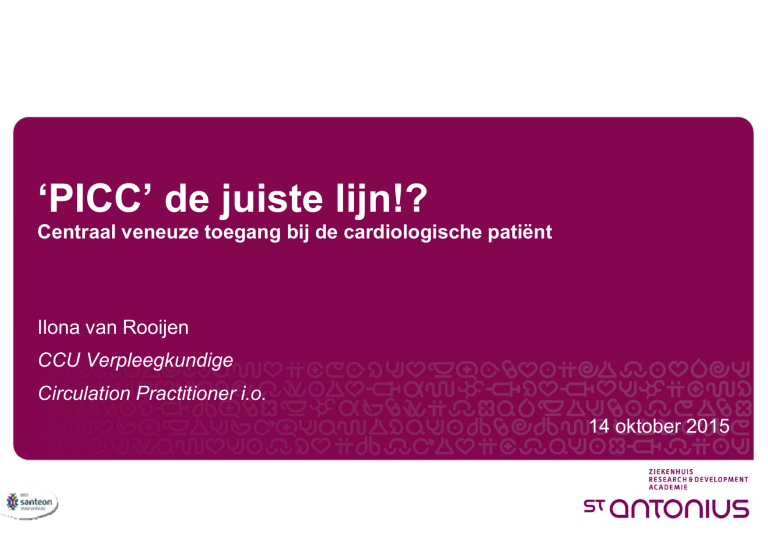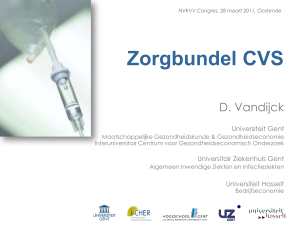
‘PICC’ de juiste lijn!?
Centraal veneuze toegang bij de cardiologische patiënt
Ilona van Rooijen
CCU Verpleegkundige
Circulation Practitioner i.o.
14 oktober 2015
Introductie
St. Antonius Ziekenhuis
5 locaties; gezamenlijk 850 bedden
jaarlijks 548.000 polikliniekbezoeken
Hartcentrum
Zorgeenheid Hart
• Afdeling Cardiologie/CCU (E3) locatie Nieuwegein
• 32 cardiologische bedden
• 9 EHH bedden
• 14-18 level 2 CCU bedden
www.antoniusziekenhuis.nl
• 2014: 2700 opnames
1
'PICC' de juiste lijn!? | Ilona van Rooijen | 14 oktober 2015
Inhoud
• CVC en PICC
• Aanleiding
• Onderzoeksvraag
• Methode
• Resultaten
• Discussie
• Conclusie
• Aanbevelingen
• Rol Circulation Practitioner
• Dankwoord
• Bronnen
www.angiodynamics.com Bioflo PICC
2
'PICC' de juiste lijn!? | Ilona van Rooijen | 14 oktober 2015
CVC en PICC
Centraal veneuze catheter (CVC)
Peripherally inserted central catheter (PICC)
v. jugularis interna, v. subclavia of v. femoralis
v. basilica, v. brachialis of v. cephalica
www.wikipedia.org
3
'PICC' de juiste lijn!? | Ilona van Rooijen | 14 oktober 2015
Aanleiding
• Zorgen rondom de nadelige gevolgen van een CVC
Lijnsepsis, pneumo- hemothorax, arterieel aanprikken, ongemak
voor de patiënt, etc.
• Patiëntencategorie waarbij centrale toegang noodzakelijk is
Indicaties:
• Langdurige i.v. medicatie
• Irriterend
• Moeizaam te prikken
• Thuisbehandeling
• Steeds vaker de PICC
Veilig in te brengen en voordelen van centrale toegang
Angiodynamics en I. van Rooijen
4
'PICC' de juiste lijn!? | Ilona van Rooijen | 14 oktober 2015
Aanleiding
Centraal veneuze catheter (CVC)
Peripherally inserted central catheter (PICC)
v. jugularis interna, v. subclavia of v. femoralis
v. basilica, v. brachialis of v. cephalica
www.wikipedia.org
5
'PICC' de juiste lijn!? | Ilona van Rooijen | 14 oktober 2015
Onderzoekvraag
Welke voordelen brengt de PICC voor de cardiologische patiënt, waarbij
een centrale veneuze toegang voor medicatietoediening gewenst is, ten
opzichte van de CVC?
1. Hoeveel patiënten komen er in aanmerking voor een PICC?
2. Wat zijn de kosten voor beide catheters?
3. Welke voordelen en complicatierisico’s van de PICC gelden voor de
cardiologische patiënt?
6
'PICC' de juiste lijn!? | Ilona van Rooijen | 14 oktober 2015
Methode
1. Lijnenregistratie 2014-2015
(vooraf opgestelde in- en exclusiecriteria)
2. Bereken kosten voor inbrengen, verzorgen en verwijderen
3. Literatuuronderzoek
hetleidskwartiertje.nl
7
'PICC' de juiste lijn!? | Ilona van Rooijen | 14 oktober 2015
Resultaten
1. Aantal patiënten
1. Lijnenregistratie is niet volledig
2. Eigen registratie van 2 februari tot en met 21 mei 2015
67 patiënten kregen een CVC
17 patiënten hadden een PICC kunnen krijgen, 4-5 per maand
11 patiënten kregen een PICC, 3 per maand
3. Verwachting 8 PICC’s per maand
Plaatsen door de Circulation Practitioner
PICC in plaats van perifeer infuus
8
'PICC' de juiste lijn!? | Ilona van Rooijen | 14 oktober 2015
Resultaten
2. Kosten
Verschil
€40,25
9
'PICC' de juiste lijn!? | Ilona van Rooijen | 14 oktober 2015
Verschil
€100,45
Resultaten
3. Literatuur onderzoek
• Gezocht in Pubmed en Cinahl, laatste update 28 juli 2015
16 full tekst artikelen
• Veel artikelen over bloedbaaninfectie (BSI) en veneuze trombose
Waaronder 4 systematisch reviews, waarvan 3 meta analyses
• Beperkt aantal onderzoeken over de cardiologische patiënt 3 artikelen
observationele cohortstudies, 2 retrospectief, 1 prospectief
10
'PICC' de juiste lijn!? | Ilona van Rooijen | 14 oktober 2015
Resultaten
3. Literatuur onderzoek
PICC vs. CVC
Voordelen
Nadelen
Veilig (laag risico misplaatsen)
Niet in acute situatie
Gemakkelijk (echo geleid)
CVD meting
Perifeer ingebracht, centraal gelegen
Hogere kans trombose
Niet platliggen
Contra-indicaties PICC
Lager bloedingsrisico
Thuisbehandeling
Minder beperkt
Door opgeleide verpleegkundige
11
'PICC' de juiste lijn!? | Ilona van Rooijen | 14 oktober 2015
Resultaten
3. Literatuur onderzoek
Bloedbaaninfectie
Overall
Klinische patiënt
Poliklinische
patiënt
Maki
PICC
CVC
PICC
PICC
et al.
1.1 per 1000
2.7 per 1000
2.1 per 1000
1.0 per 1000
catheterdagen
catheterdagen
catheterdagen
catheterdagen
95% CI 0.9-1.3
95% CI 2.6-2.9
95% CI 1.0-3.2
95% CI 0.8-1.2
RR [95% CI],
RR [95% CI],
RR [95% CI],
0.62 [0.40-0.94]
0.73 [0.54-0.98]
0.22 [0.18-0.27]
IRR [95% CI],
IRR [95% CI],
IRR [95% CI],
0.91 [0.46-1.79]
0.72 [0.41-1.72]
0.72 [0.58-0.88]
(2006)9
Chopra
et al.
(2013)4
12
'PICC' de juiste lijn!? | Ilona van Rooijen | 14 oktober 2015
Chopra et. al
20134
13
'PICC' de juiste lijn!? | Ilona van Rooijen | 14 oktober 2015
Chopra et. al
20134
14
'PICC' de juiste lijn!? | Ilona van Rooijen | 14 oktober 2015
Resultaten
3. Literatuur onderzoek
Trombose
Chopra et al. (2013)5
OR [95% CI] 2.55 [1.54-4.23] p<0.0001
Chopra et al. 20135
15
'PICC' de juiste lijn!? | Ilona van Rooijen | 14 oktober 2015
Resultaten
3. Literatuur onderzoek
Risico factoren PICC gerelateerde trombose
Chopra et al. (2013)5
Leung et al. (2015)14
Marnejon et al. (2012)13
ICU patiënten
Leeftijd
Trauma patiënten
Patiënten met kanker
Maligniteiten
Nierfalen
Chopra et al. (2014)15
Diabetes Mellitus
Linkszijdige catheter
Recente diagnose kanker
Obesitas
V. basilica
Grotere gauge
Chemotherapie
Parenterale Voeding
Trombofilie
Antibiotica (voornamelijk
Voorgeschiedenis
vancomycine)
trombose
16
'PICC' de juiste lijn!? | Ilona van Rooijen | 14 oktober 2015
Resultaten
3. Literatuur onderzoek
Cardiologische patiënt
PICC
Major
Kosteneffectief
et al.
Vermindering ligduur
(2000)16
Verbetering patiënten tevredenheid
CMP
PICC AE’s
PICC
PICC infectie
Haglund et
3.69 per 1000
VTE/bloeding
3.26 per 1000
al. (2014).17
catheterdagen
0.4 per 1000
catheterdagen
CMP
(IQR 2.77-4.80)
catheterdagen
(IQR 2.39-4.30)
(IQR 0.1-0.9)
Infectie meest voorkomende complicatie hogere kosten
- Aantal lumen
- duur
De Paula et Veilige alternatief voor langdurige i.v. AB
al. (2012)18 Minder risico op lijninfectie
Meer occlusie
IE
17
'PICC' de juiste lijn!? | Ilona van Rooijen | 14 oktober 2015
CVC
Geen vergelijking met
CVC
Geen vergelijking met
CVC
Meer koorts en
bacteriëmieën
Risico op lijninfectie
(nieuwe episode IE)
Discussie
1. Lijnenregistratie
Geen registratie van perifere infusen
2. Kosteneffectief
3. Cardiologische patiënt
loesje.nl
18
'PICC' de juiste lijn!? | Ilona van Rooijen | 14 oktober 2015
Conclusie
• De PICC is een goed alternatief voor de CVC
Belangrijke voordelen:
Veilig en gemakkelijk
Perifeer ingebracht, centraal gelegen
Comfort
• Gemiddeld 8 patiënten per maand
• Voordeliger bij langdurig gebruik
• Lager risico op BSI bij de poliklinische patiënt
• Risco op DVT
• Bewust wording van risicofactoren
19
'PICC' de juiste lijn!? | Ilona van Rooijen | 14 oktober 2015
www.angiodynamics.com
Aanbevelingen
1. De PICC bij de cardiologische patiënt
die langdurige i.v. toegang nodig heeft
2. Inbrengen van de PICC door opgeleide CP’s
3. Beslisboom
4. Uitbreiden en verbeteren van de lijnenregistratie
5. Onderzoek naar de PICC bij de cardiologische patiënt
www.angiodynamics.com Bioflo PICC
20
'PICC' de juiste lijn!? | Ilona van Rooijen | 14 oktober 2015
Rol Circulation Practitioner
Vakmanschap, vertrouwen en verbinden…
Innovatie
Persoonlijke
ontwikkeling
Coachen en
begeleiden
CP
Research
Samenwerking
Management
21
'PICC' de juiste lijn!? | Ilona van Rooijen | 14 oktober 2015
Dankwoord
Dank voor jullie tijd en luisterend oor!
• Benno Rensing, Henny Agelink en Harold in ‘t Veld
• Marieke Mulder
• Familie en collega’s
• Collega CP’s
• CTG
22
'PICC' de juiste lijn!? | Ilona van Rooijen | 14 oktober 2015
Bronnen
1. Marino, P. (2014). The ICU Book: Fourth Edition. Philadelphia: Wolters Kluwer Health.
2. Johansson, E., Hammarskjöld, F., Lundberg, D., & Arnlind, M. (2013). Advantages and disadvantages of peripherally inserted central venous catheters
(PICC) compared to other central venous lines: A systematic review of the literature. Acta Oncologica, 886-892.
3. Cotogni, P., & Pittiruti, M. (2014). Focus on peripherally inserted central catheters in critically ill patients. World J Crit Care Med, 80-94.
4. Chopra, V., O'Horo, J. C., Rogers, M. A., Maki, D. G., & Safdar, N. (2013). The risk of bloodstream Infection associated with peripherally inserted central
catheters compared with central venous catheters in adults: A systematic review and meta-analysis. Infection Control and Hospital Epidemiology, 908-918.
5. Chopra, V., Anand, S., Hickner, A., Buist, M., Rogers, M., Saint, S., & Flanders, S. (2013). Risk of venous thromboembolism associated with peripherally
inserted central catheters: a systematic review and meta-analysis. The Lancet, 311-325.
6. ECS. (2009). Guidelines on the prevention, diagnosis, and treatment of infective endocarditis (new version 2009). European Heart Journal, 2369-2413.
7. Chopra, V., Anand, S., Krein, S., & Chenoweth, C. (2012). Bloodstream infection, venous thrombosis, and peripherally inserted central catheters:
Reappraising the evidence. The American Journal of Medicine, 733-741.
8. Chopra, V., Flanders, S. A., & Saint, S. (2014). The problem with peripherally inserted central catheters. American Medical Association, 1527-1528.
9. Maki, D., Kluger, D., & Crnich, C. (2006). The risk of bloodstream infection in adults with different intravascular devices: a systematic review of 200
published prospective studies. Mayo Clin Proc, 1159-1171.
10. VMS. (2012). Voorkomen van lijnsepsis en behandeling van ernstige sepsis.
11. Chopra, V., Ratz, D., Kuhn, L., Lopus, T., Chenoweth, C., & Krein, S. (2014). PICC-associated bloodstream infections: prevalence, patterns, and
predictors. The American Journal of Medicine, 319-328.
12. Pongruangporn, M., Ajenjo, M. C., Russo, A. J., McMullen, K. M., Robinson, C., Williams, R. C., & Warren, D. K. (2013). Patient- and device specific risk
factorsnfor pheripherally inserted central venous catheter-related bloodstream infections. Infection Control and Hospital Epidemiology, 184-189.
13. Marnejon, T., Angelo, D., Abdou, A., & Gemmel, D. (2012). Risk factors for upper extremity venous thrombosis associated with peripherally inserted
central venous catheters. Journal Vasc Acces, 231-238.
14. Leung, A., Heal, C., & Perera, M. (2015). A systematic review of patient-related risk factors for catheter-related thrombosis. Journal of thrombosis and
thrombolysis.
15. Chopra, V., Ratz, D., Kuhn, L., Lopus, T., Lee, A., & Krein, S. (2014). Peripherally inserted central catheter-related deep vein thrombosis: contempory
patterns and predictors. Journal of Thrombois and Haemostatis, 847-854.
16. Major, B., & Crow, M. (2000). Peripherally inserted central catheters in the patient with cardiomyopathy: The most cost-effective venous access. Journal of
intravenous Nursing, 366-370.
17. Haglund, N. A., Cox, Z. L., Lee, J. T., Song, Y., Keebler, M. E., Disalvo, T. G., Maltais, S., Lenihan, D. J., Wigger, M. A. (2014). Are peripherally inserted
central catheters associated with increased risk of adverse events in status 1B patients awaiting transplantation on cantinuous intravenous milrinone?
Journal Of Cardiac Failure, 630-637.
18. De Paula, D., Tura, B., & Lamas, C. d. (2012). Adverse events related to intravenous antibiotic therapy: a prospective observational study in the treatment
of infective endocarditis. BMJ Open, 1-6.
19. Pittirut, M., Brutti, A., Celentano, D., Pomponi, M., Biasucc, D., Annetta, M., & Scoppettuolo, G. (2012). Clinical experience with power-injectable PICCs in
intensive care patients. Critical Care, 1-7.
23
'PICC' de juiste lijn!? | Ilona van Rooijen | 14 oktober 2015
DANK U
24
'PICC' de juiste lijn!? | Ilona van Rooijen | 14 oktober 2015











